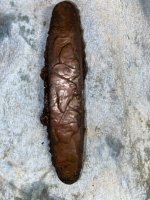UncleMatt
Bronze Member
- Jul 14, 2012
- 2,389
- 2,530
- Detector(s) used
- Garrett Infinium & Gold Bug II, Bazooka Super Prospector Sluice
- Primary Interest:
- All Treasure Hunting
Hi All,
Last night I checked out a new show on Discovery Channel called Cooper's Treasure. This show is based on the observations of an astronaut that were made while he was orbiting the earth in a Mercury space capsule in the 1960's. Here is a link to the website for the show:
About Cooper?s Treasure | Cooper's Treasure | Discovery
In last night's show they briefly discussed the idea that a top top secret long range sensor could have been installed in the capsule that could detect large masses of metal from orbit. This is where they lost me. I am not aware of any such technology that exists today that could pull that off today, let alone in the 1960's.
In my humble opinion such a sensor would need to be passive in the sense it would have to detect changes created by large metal masses in the Earth's magnetic field, or some other aspect of the environment. My reasoning on that is based on the fact that Mercury space capsules were very small and could not have carried a large power source. So no lasers or radar or anything like that would have been achievable, even if that technology existed at that time.
But hey, I am always open to alternative viewpoints, and would like to discuss what all of you think might have been employed to detect the large metal masses that Gordon Cooper was searching for on his record breaking mission of 122 hours in space. What long range sensors could pull that off, and could they have been used in that mission to try to detect nuclear warheads and technology in the 1960's? Please be prepared to back up any theories you have on this with verifiable sources.
Thanks!
Last night I checked out a new show on Discovery Channel called Cooper's Treasure. This show is based on the observations of an astronaut that were made while he was orbiting the earth in a Mercury space capsule in the 1960's. Here is a link to the website for the show:
About Cooper?s Treasure | Cooper's Treasure | Discovery
In last night's show they briefly discussed the idea that a top top secret long range sensor could have been installed in the capsule that could detect large masses of metal from orbit. This is where they lost me. I am not aware of any such technology that exists today that could pull that off today, let alone in the 1960's.
In my humble opinion such a sensor would need to be passive in the sense it would have to detect changes created by large metal masses in the Earth's magnetic field, or some other aspect of the environment. My reasoning on that is based on the fact that Mercury space capsules were very small and could not have carried a large power source. So no lasers or radar or anything like that would have been achievable, even if that technology existed at that time.
But hey, I am always open to alternative viewpoints, and would like to discuss what all of you think might have been employed to detect the large metal masses that Gordon Cooper was searching for on his record breaking mission of 122 hours in space. What long range sensors could pull that off, and could they have been used in that mission to try to detect nuclear warheads and technology in the 1960's? Please be prepared to back up any theories you have on this with verifiable sources.
Thanks!





